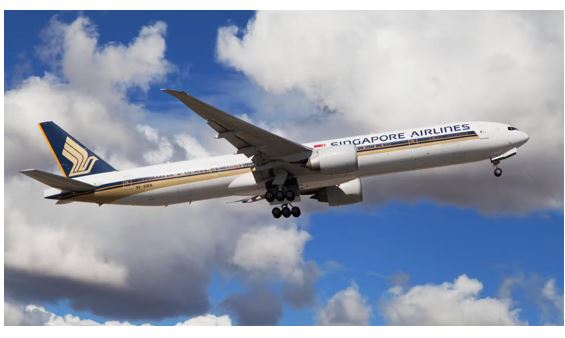Beware of the Weather Gods – By Capt Elmo Jayawardena
 The one thing that a pilot wishes for, when he lines up for take-off is a blue sky. He rolls his aeroplane down the runway with engines screaming at take-off power, and at rotational speed, he eases the aeroplane into the sky. Then he retracts the gear and the flaps, which is commonly called cleaning the aircraft and then sets the course in the direction of his destination. Whether it is an intercontinental fifteen-hour flight or a local one hour’s run from Ratmalana to Jaffna, the pilot has one ultra-important wish. That is to have a domed blue sky throughout his journey. From the pencil thin line of a cirrus cloud in the upper sky to a bulging rain laden towering cumulus the sky gods await the unfortunate pilot who is a permissionless intruder stubbornly trespassing their domain. The Gods are watching, Thor from Norse mythology, Zeus from the Greeks and God Indra the oldest known sky owner according to Hinduism. The belief that the sky belongs to the Gods is a phenomenon pre 1400 B.C with the Hittites worshipping God Indra from Anatolia which is in present day Turkey.
The one thing that a pilot wishes for, when he lines up for take-off is a blue sky. He rolls his aeroplane down the runway with engines screaming at take-off power, and at rotational speed, he eases the aeroplane into the sky. Then he retracts the gear and the flaps, which is commonly called cleaning the aircraft and then sets the course in the direction of his destination. Whether it is an intercontinental fifteen-hour flight or a local one hour’s run from Ratmalana to Jaffna, the pilot has one ultra-important wish. That is to have a domed blue sky throughout his journey. From the pencil thin line of a cirrus cloud in the upper sky to a bulging rain laden towering cumulus the sky gods await the unfortunate pilot who is a permissionless intruder stubbornly trespassing their domain. The Gods are watching, Thor from Norse mythology, Zeus from the Greeks and God Indra the oldest known sky owner according to Hinduism. The belief that the sky belongs to the Gods is a phenomenon pre 1400 B.C with the Hittites worshipping God Indra from Anatolia which is in present day Turkey.
The weather gods had the most devastating weaponry to discourage anyone who wanted to fly. They controlled the winds, cross winds, wind shears and backing and veering gusting winds that have always been a bane to pilots. Then came rain, thunder and lightning, giving all kinds of turbulence which are perpetual hazards in the sky. Icing has always been deadly with the ultimate of freezing rain. Fog and mist were the cheating kind that fooled the pilots with their vertical good visibility and impossibly blinding slant visibility. The nuclear part of the weather gods’ armament was clear air turbulence that never showed on the radar to give a warning to the pilot.

All these and more are the weapons with which the weather gods taunted the best of pilots in their imitation to be half birds. How the weather gods wrote off aeroplanes and those who flew in them has been tragical. But sadly, today it has become a mere statistic.
Let’s go mythological as most of the advancements in technology has still not found a fool proof answer for a pilot to fly the sky with knowledge and operational skills that would defeat the weather gods. The one partial solution is to fly a blue sky, but such is an impossibility in modern day commercial aviation especially with long-haul flying.

Singapore Airlines had an incident over the Myanmar skies. They were cruising at 37,000 feet flying from London to Singapore. The aeroplane was a Boeing 777. I do not know who the pilots were or what happened to the aircraft path when it encountered turbulence. The Captain diverted to Bangkok and landed. One passenger sadly died of a heart attack and 30 others were injured. That part of the story is very sad. I do not know who lost his life and who were the 30 injured. They were all people who boarded a plane in London and sat watching TV and eating meals enjoying SIA’s renowned cabin service. The last thing on their minds would have been the aeroplane going into unusual attitude in turbulence, and the catastrophe that took place which sent the passengers from calm to chaos.
In my humble opinion, the Captain did the right thing. Controlled the plane and evaluated the options and took a safe decision to land as soon as possible. He headed for Bangkok. The aeroplane landed safely at Suvarnabhumi International Airport. SIA ground staff would have set in motion their instant-action game plans as soon as the passengers disembarked. Singapore Airlines is pretty good when it comes to handling emergencies. As I write this on Thursday the 23rd morning, matters are being attended to especially with passengers who needed medical assistance and hospitalization in Bangkok. A relief plane had flown from Singapore to bring back the other passengers. They also sent a special team of SIA staff to Bangkok to take care of all arrangements. I do not know all the details, but I am sure SIA knew what to do when the chips are down.
The question then is how did a modern sophisticated jet aeroplane encounter such severe turbulence that injured 30 passengers and caused a fatal heart attack to a 73-year-old gentleman? It is the wrath of the weather gods that mere human beings will never totally understand. The anger of the sky is unbelievable and the devastation it can cause to an aeroplane is unimaginable to a layman. Yes, the planes are equipped with the most advanced weather radar systems enabling the pilots to meander through cloud filled skies. Yet, aeroplanes encounter weather practically on every flight. How often do we see the seat belts sign coming on and the announcement being made “Ladies and gentlemen, please fasten your seat belts, as we are flying through turbulent weather”. Most times it’s just a bit of rock and roll and the plane clears the cloud, and the seat belt sign is switched off by the pilots. Sometimes the intensity of the ‘rock and roll’ can be alarming and vicious and the Captain then makes an announcement to suspend the services and for the crew to take their seats. All these are norms in flying.
But sometimes the weather gods can hit you with no warning at all. That is a phenomenon known as clear air turbulence. The radar does not show it and the sky can be clear without giving any warning to the unsuspecting pilot. That is possibly what happened to the SQ aeroplane in the Burmese sky. They may have hit some heavy clear air turbulence that would have made a mockery of their flight instruments. The auto pilot may have tripped, and the aeroplane would have moved to an unusual attitude. I have no clue about what happened in that cockpit of SQ 321. I am only giving some plausible explanation to a layman reader to get an idea of what may have happened.
The pilots would have reacted instantly and correctly and brought the aeroplane under control. All this would have happened so fast and once the plane came out of the turbulence, the Captain would have ascertained from the cabin crew whether anyone was injured. With an affirmative answer the Captain would have decided to fly to an enroute alternate and the most suitable would have been Bangkok.
Flying in a cloud filled sky is not something new to a pilot. Any pilot with four stripes would have battled with adverse weather more times than he or she cared to remember. Too many pilots have met their end in aeroplanes killed by the weather gods who took advantage of the fallibility of mere mortals and their manmade machines. The one safety net the pilot had to battle weather was pure preparedness and continuous situational awareness. Of course, ‘D team’ attitude to flying is indeed a humbling advantage for a pilot to adopt. It is always better not to be in the A team or the B team or the C team when flying. The trick was to fly in the D team, nothing fancy, just safe from departure to destination. That was the best commandment to follow when flying.
In the years gone by I used to fly as a co-pilot on old Dakota planes. This was the 70s and I flew for Air Ceylon. The Dakota was a second world war relic and was a wonderful old workhorse. It had no radar but the captains we flew with were veterans who scanned the skies with their naked eyes and flew the Dakotas in the worst of monsoon rains. The years rolled, and I crawled up to fly big jets and was instructing the young to fly. Of course, by that time we always had two radar sets with colour codes. The clouds in our path were depicted in three colours. Green for mild clouds and amber for medium hazards and red for absolute terror clouds filled with turbulence.
I taught my students to fly the weather radar remembering the story of Goldilocks. The red area on the screen was the father bear clouds, the amber was mother bear clouds and the green was the baby bear clouds.
Forget the father bear and the mother bear, they could kill you. And that green bastard of a baby bear is vicious enough to kick you out of the sky.
I survived.
SQ 321 and the incident over the Myanmar airspace has woken a lot of people to the possible hazards of weather encountered by aeroplanes. King Ravana is the oldest pilot we know who flew the Dandumonara more than 5000 years ago. From him to the modern-day airline pilot, both inclusive, all would have battled the weather gods every time they went into the sky. Nothing has changed, the weather gods are still dominating the yonder blue, and on a daily basis they throw varying obstacles to those who fly. Most times such challenges are manageable. The pilot and his sophisticated machine are capable. They are backed by a vast safety system that monitors and protects aviation and the planes that fly in the sky. This is world-wide and very well organized. That is why flying is safe and people fly.
Off and on the weather gods get mischievous and go beyond the beyond.
But the pilots and the vast aviation system manage to balance the act and live to fly another day.
That is the norm, of course there are exceptions.
Capt Elmo Jayawardena







